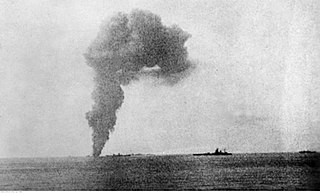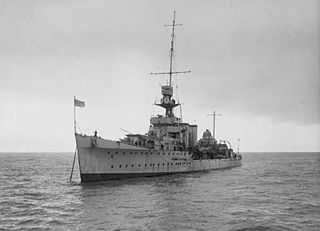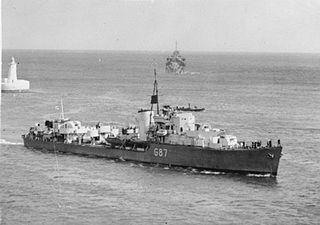
HMS Hotspur was an H-class destroyer built for the Royal Navy during the 1930s. During the Spanish Civil War of 1936–1939 the ship spent considerable time in Spanish waters, enforcing the arms blockade imposed by Britain and France on both sides of the conflict. During the Norwegian Campaign of the Second World War, she fought in the First Battle of Narvik in April 1940 where she was badly damaged. After her repairs were completed, Hotspur was transferred to Gibraltar where she participated in the Battle of Dakar in September. A month later the ship was badly damaged when she rammed and sank an Italian submarine. She received permanent repairs in Malta and was transferred to the Mediterranean Fleet when they were finished in early 1941. Hotspur participated in the Battle of Cape Matapan in March and evacuated British and Australian troops from both Greece and Crete in April–May. In June the ship participated in the Syria-Lebanon Campaign and was escorting convoys and the larger ships of the Mediterranean Fleet until she was transferred to the Eastern Fleet in March 1942.

HMS Hero was an H-class destroyer built for the Royal Navy in the mid-1930s. During the Spanish Civil War of 1936–1939 the ship enforced the arms blockade imposed by Britain and France on both sides as part of the Mediterranean Fleet. During the first few months of World War II, Hero searched for German commerce raiders in the Atlantic Ocean and participated in the Second Battle of Narvik during the Norwegian Campaign of April–June 1940 before she was transferred to the Mediterranean Fleet in May where she escorted a number of convoys to Malta. The ship took part in the Battle of Cape Spada in July 1940, Operation Abstention in February 1941, and the evacuations of Greece and Crete in April–May 1941.

Operation Pedestal, known in Malta as Il-Konvoj ta' Santa Marija, was a British operation to carry supplies to the island of Malta in August 1942, during the Second World War. Malta was a base from which British ships, submarines and aircraft attacked Axis convoys to Libya, during the North African Campaign (1940–1943). From 1940 to 1942, the Axis conducted the Siege of Malta, with air and naval forces. Despite many losses, enough supplies were delivered by the British for the population and military forces on Malta to resist, although it ceased to be an offensive base for much of 1942. The most crucial supply item in Operation Pedestal was fuel, carried by SS Ohio, an American tanker with a British crew. The convoy sailed from Britain on 3 August 1942 and passed through the Strait of Gibraltar into the Mediterranean on the night of 9/10 August.

The C and D class was a group of 14 destroyers built for the Royal Navy in the early 1930s. As in previous years, it was originally intended to order a complete flotilla comprising eight destroyers—plus a flotilla leader as the ninth unit—in each year. However, only four ships—plus a leader—were ordered under the 1929–1930 Programme as the C class. The other four ships planned for the C class were never ordered as an economy measure and disarmament gesture by the Labour government of Ramsay MacDonald. A complete flotilla—the 'D' class—was ordered under the 1930–1931 Programme.

The First Battle of Sirte was fought between the British Royal Navy and the Regia Marina during the Mediterranean campaign of the Second World War. The engagement took place on 17 December 1941, south-east of Malta, in the Gulf of Sirte. It was tactically inconclusive as both forces were limited by the strategic goal of protecting a convoy of their own and as such, neither were looking to force a full scale engagement.

Operation Stoneage or Operation Stone Age was an Allied convoy operation to the Mediterranean island of Malta in the Second World War. To disguise the destination of the ships, some took on their cargo at Port Sudan in the Red Sea. The four ships of Convoy MW 13 sailed from Alexandria on 16 November, escorted by cruisers, destroyers and round-the-clock air cover from captured airfields in Egypt and Cyrenaica.

The Malta convoys were Allied supply convoys of the Second World War. The convoys took place during the Siege of Malta in the Mediterranean Theatre. Malta was a base from which British sea and air forces could attack ships carrying supplies from Europe to Italian Libya. Britain fought the Western Desert Campaign against Axis armies in North Africa to keep the Suez Canal and to control Middle Eastern oil. The strategic value of Malta was so great the British risked many merchant vessels and warships to supply the island and the Axis made determined efforts to neutralise the island as an offensive base.

HMS Charybdis was a Dido-class cruiser built for the Royal Navy during the Second World War and was sunk with heavy loss of life by German torpedo boats in an action in the English Channel in October 1943.

Operation Harpoon or Battle of Pantelleria was one of two simultaneous Allied convoys sent to supply Malta in the Axis-dominated central Mediterranean Sea in mid-June 1942, during the Second World War. Operation Vigorous was a westward convoy from Alexandria run at the same time Operation Harpoon was an eastbound convoy operation from Gibraltar. Two of the six ships in the Harpoon convoy completed the journey, at the cost of several Allied warships. The Vigorous convoy was driven back by the Italian fleet and attacks by Axis aircraft.

Operation Vigorous was a British operation during the Second World War, to escort supply convoy MW11 from the eastern Mediterranean to Malta, which took place from 11 to 16 June 1942. Vigorous was part of Operation Julius, a simultaneous operation with Operation Harpoon from Gibraltar and supporting operations. Sub-convoy MW11c sailed from Port Said (Egypt) on 11 June, to tempt the Italian battlefleet to sail early, use up fuel and be exposed to submarine and air attack. MW11a and MW11b sailed next day from Haifa, Port Said and Alexandria; one ship was sent back because of defects. Italian and German (Axis) aircraft attacked MW11c on 12 June and a damaged ship was diverted to Tobruk, just east of Gazala. The merchant ships and escorts rendezvoused on 13 June. The British plans were revealed unwittingly to the Axis by the US Military Attaché in Egypt, Colonel Bonner Fellers, who reported to Washington, D.C. in "Black"-coded wireless messages; it was later discovered that the Black Code had been broken by the Servizio Informazioni Militare.

Operation Substance was a British naval operation in July 1941 during the Second World War to escort convoy GM 1, the first of the series from Gibraltar to Malta. The convoy defended by Force H was attacked by Italian submarines, aircraft, and Motoscafo armato silurante.

HMS Abdiel was an Abdiel-class minelayer that served with the Royal Navy during World War II. She served with the Mediterranean Fleet (1941), Eastern Fleet (1942), Home Fleet (1942–43), and the Mediterranean Fleet (1943). Abdiel was sunk by German mines in Italy's Taranto harbour in 1943. Although designed as a fast minelayer her speed and capacity made her suitable for employment as a fast transport.

HMS Tartar was a Tribal-class destroyer of the Royal Navy that saw service in most of the naval theatres of World War II. She had an eventful career, eventually receiving the nickname 'Lucky Tartar' due to her numerous escapes from dangerous situations. She was one of only four from the sixteen Royal Navy-operated Tribal-class destroyers to survive the war.

HMS Calcutta was a C-class light cruiser of the Royal Navy, named after the Indian city of Calcutta. She was part of the Carlisle group of the C-class of cruisers. She was laid down by Vickers Limited at Barrow-in-Furness in 1917 and launched on 9 July 1918. Calcutta was commissioned too late to see action in the First World War and was converted to an anti-aircraft cruiser in 1939. Calcutta served during the Norwegian Campaign and the evacuation from Dunkirk in 1940. She was used to escort allied convoys across the Mediterranean and was sunk on 1 June 1941 by Luftwaffe aircraft off Alexandria, Egypt.

HMS Defender was a D-class destroyer built for the Royal Navy in the early 1930s. The ship was initially assigned to the Mediterranean Fleet before she was transferred to the China Station in early 1935. She was temporarily deployed in the Red Sea during late 1935 during the Abyssinia Crisis, before returning to her assigned station where she remained until mid-1939. Defender was transferred back to the Mediterranean Fleet just before World War II began in September 1939. She briefly was assigned to West Africa for convoy escort duties in 1940 before returning to the Mediterranean. The ship participated in the Battles of Calabria, Cape Spartivento, and Cape Matapan over the next year without damage. Defender assisted in the evacuations from Greece and Crete in April–May 1941, before she began running supply missions to Tobruk, Libya in June. The ship was badly damaged by a German bomber on one of those missions and had to be scuttled by her consort on 11 July 1941.

HMS Lance was an L-class destroyer of the Royal Navy. She entered service during World War II, and had a short but eventful career, serving in Home waters and the Mediterranean Sea. She was damaged in two consecutive air attacks at Malta in 1942. She was towed back to Britain, declared a constructive total loss and was scrapped. She had been adopted by the civil community of Bexley and Welling, Kent in November 1941.

HMS Latona was an Abdiel-class minelayer of the Royal Navy. She served briefly during the Second World War, but was sunk less than six months after commissioning.

HMS Tetcott was a Type II British Hunt-class destroyer built for the Royal Navy during World War II. She was the only Royal Navy ship to be named after the Tetcott fox hunt.

HMS Lively was an L-class destroyer of the Royal Navy. She served during the Second World War, and was sunk in the Mediterranean in an air attack on 11 May 1942.

HMS Apollo was an Abdiel-class minelayer of the Royal Navy, the eighth RN ship to carry the name. She served with the Home Fleet during World War II, taking part in the Normandy Landings before being transferred to the British Pacific Fleet. Put into reserve in 1946, she was recommissioned in 1951, serving until 1961, and was sold for scrapping in 1962.


















